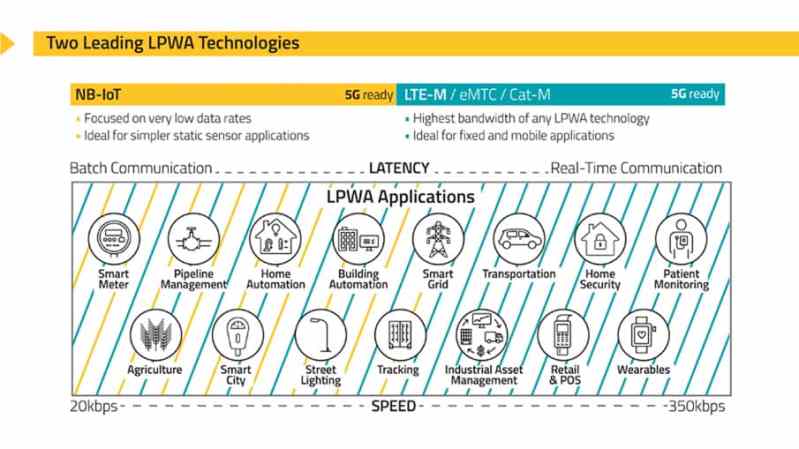April 3, 2018

Related Blogs:
Sign up for blog updates
Get innovation delivered to your inbox. Sign up for our blog and stay on top of the very latest from Semtech (formerly Sierra Wireless).
April 3, 2018

LTE-M (also known as eMTC and Cat-M1) and NB-IoT are both good connectivity options for industries looking to take advantage of Low Power Wide Area Network (LPWAN) technology. But which is the best choice for your low-power IoT application?
Deciding between LTE-M and NB-IoT requires an understanding of the key differences between these two technologies, such as latency and speed. Carefully consider what your needs are before you decide on a solution. In some cases, you may find that you don’t have to make a choice between the two options at all; some applications get the same benefits from both. After analyzing the similarities and differences between LTE-M and NB-IoT, you can make an informed decision that will set your system up for success well into the future.

So, what exactly are the differences between LTE-M and NB-IoT? Both are LPWA technologies for low-bandwidth IoT applications defined by the 3GPP in Release 13 and meet the requirements for low cost, low-power and extended coverage. The choice between LTE-M and NB-IoT depends largely upon the amount of data that you plan on using and how much latency is acceptable for your application (i.e. whether or not you require real-time communication).
Latency
Latency is the amount of time it takes to get on a network and send a message. A device can either collect information and send a packet to the cloud in intervals or it can communicate in real time. This is where you’ll see the most difference between LTE-M and NB-IoT.
For mission-critical applications, LTE-M is the only option. It supports devices that need to communicate in real time to ensure the application meets user-experience requirements. Some examples of real-time communication include voice, emergency data and precision tracking data. When it comes to voice, there are a couple things to clarify. First, although LTE-M technology supports voice, it will be up to each network operator as to whether or not it gets implemented on their LTE-M network. Second, in extended coverage situations, voice would not work at all with LTE-M — voice is only supported in standard coverage scenarios.

Speed
Higher speeds mean that you can push more data through the network in a given timeframe. Speed is especially important for more data-intensive IoT applications like home security or wearable devices. Although LTE-M will never compete with the standard LTE and LTE-Advanced network bandwidth or speeds, it does allow for more data throughput compared to NB-IoT.
Another important fact to consider is that there are no NB-IoT use cases that LTE-M can’t also support. In other words, LTE-M supports any LPWA application, whereas NB-IoT is designed for simpler static sensor type applications.
If you’re still unsure about which option is the best fit for your application, then look for current use cases of LPWA/LPWAN technology. For instance, patient monitoring devices would likely require real-time communication leaving LTE-M as the clear winner. However, an application like pipeline monitoring would likely work with sending batch communication and therefore either NB-IoT or LTE-M could be used. Another example where either technology could be used would be a smart city application, like waste management, where sensors report on how full a city dumpster is. You don’t need up-to-the-second alerts on this type of information—you can receive updates periodically. Plus, there’s very little data to report at any given time. For these types of applications, you have the flexibility to choose based on regional availability or pricing.
Whether you go with an LTE-M or NB-IoT solution, Sierra Wireless can help you find the best modules and services to future proof your LPWA deployments. Start with Sierra today to find out more about the first steps to take for your low-power IoT application. Watch the webinars, Designing Low-Power Applications for LTE-M and NB-IoT LPWA Networks and the LPWA Expert Panel, and read the LPWA: Fact vs. Fiction whitepaper for more information.
Get innovation delivered to your inbox. Sign up for our blog and stay on top of the very latest from Semtech (formerly Sierra Wireless).